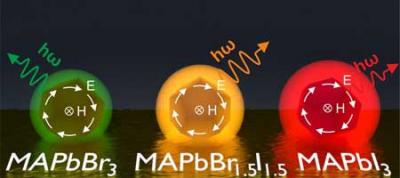Researchers from the Russian ITMO University have developed effective nanoscale light sources based on a halide perovskite. These nanosources are subwavelength nanoparticles which serve both as emitters and nanoantennas and allow enhancing light emission inherently without additional devices. Moreover, the perovskite enables tuning the emission spectra throughout a visible range by varying the composition of the material. The new nanoparticles are a promising platform for creating compact optoelectronic devices such as optical chips, light-emitting diodes, or sensors.

The nanoscale light sources and nanoantennas have already found a wide range of applications in several areas, such as ultra compact pixels, optical detection, or telecommunications. However, the fabrication of nanostructure-based devices is rather complicated due to the limited luminescence efficiency of the materials used typically as well as non-directional and relatively weak light emission of single quantum dots or molecules. An even more challenging task is placing a nanoscale light source precisely near a nanoantenna.
While studying the obtained perovskite nanoparticles, the scientists discovered that their emission can be enhanced if its spectra match with the Mie-resonant mode. "Such resonances were named in honor of Gustav Mie, an outstanding German scientist,' explains an engineer at ITMO University. 'He developed a general theory describing how the light interacts with sphere-like objects smaller than the wavelength. Currently, scientists are particularly interested in Mie-resonances related to dielectric and semiconductor nanoparticles. Perovskites used in our work are also semiconductors with luminescence efficiency much higher than that of many other materials. Our study shows that combination of excitons with the Mie resonance in perovskite nanoparticles makes them efficient light sources at room temperature."
In addition, the radiation spectrum of the nanoparticles can be changed by varying the anions in the composition of the material. "The structure of the material remains the same, we simply use another component in the synthesis of perovskite films. Therefore, it is not necessary to adjust the method each time. It remains the same, yet the emission color of our nanoparticles changes," says the team.
The scientists are currently continuing the research of light-emitting perovskite nanoantennas using various components for their synthesis. In addition, they are developing new designs of perovskite nanostructures which may improve ultra compact optical and transmission devices.